The Federal Reserve Industrial Production & Capacity Utilization report has good news and bad news. The bad news is industrial production dropped by a hefty -0.4% for August. The better news is July was revised upward by 0.3 percentage points to a 0.9% blow out increase. The further bad news is that the July increase due to by autos and parts reversed itself. After a 10.6% increase in July, Motor vehicles and parts manufacturing plunged back down by -6.4% in August. The G.17 industrial production statistical release is also known as output for factories and mines.
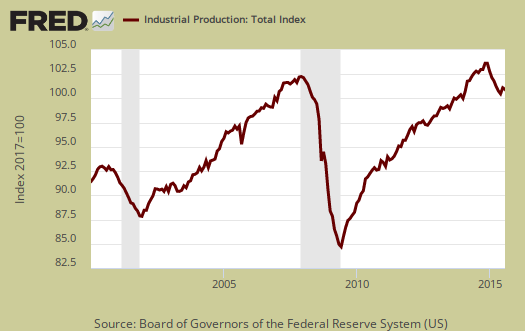
Total industrial production has now increased less than one percentage, 0.9%, from a year ago. Currently industrial production is now 7.1 percentage points above the 2012 average. Below is graph of overall industrial production's percent change from a year ago.

Here are the major industry groups industrial production percentage changes from a year ago.
- Manufacturing: +1.4%
- Mining: -3.2%
- Utilities: +3.2%
For the month manufacturing overall decreased by -0.5%. Manufacturing output is 5.3 percentage points above its 2012 Levels and is shown in the below graph.
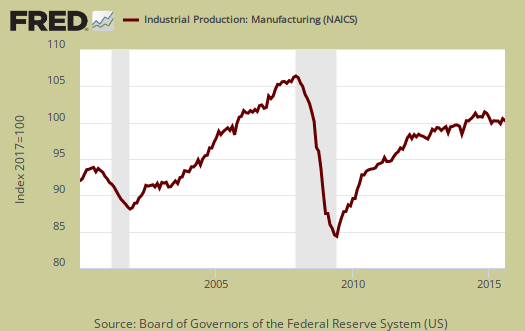
Within manufacturing, durable goods plunged by -0.9% for the month and is up 1.5% for the year. Vehicle assemblies dropped by -12%. Motor vehicles dropped by -9.1%. Without motor vehicles & parts, manufacturing would have had no change as well as overall industrial production.
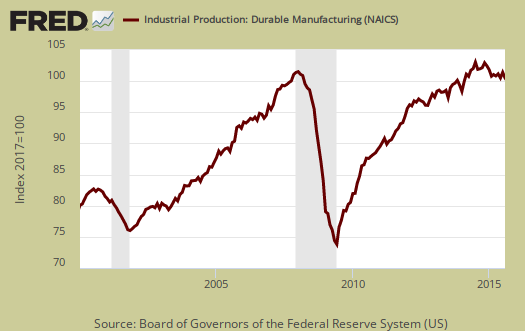
Nondurable goods manufacturing had no change for the month. Petroleum showed a -0.5% drop while food and beverages evened things out with a 0.5% increase.

Mining decreased -1.6% and is now down -3.2% for the year. Mining was seriously revised in July and increased 1.8%. Mining includes gas and electricity production and the Fed have a special aggregate index for oil and gas well drilling. Oil and gas well drilling increased 1.7% and for the year is down -53.1%.
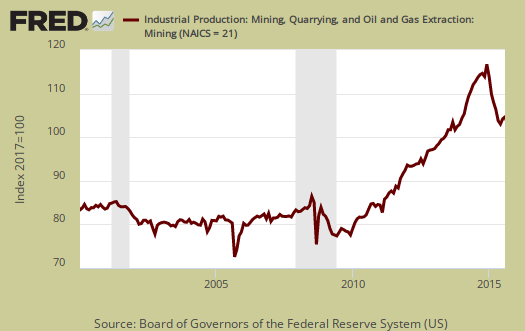
Below is oil and gas well drilling and one can see the boom and bust cycle. With recent weak demand we expect this to go down further. One analyst was predicted $20 a barrel oil.
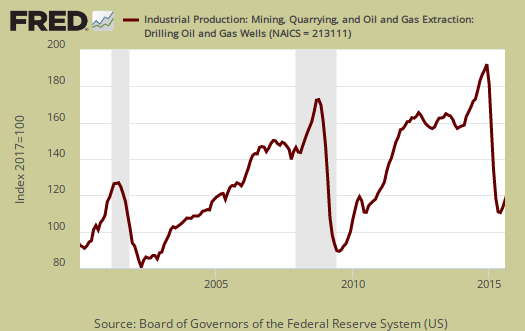
Utilities decreased by -1.0% for the month and is up 4.6% for the year. Utilities are volatile due to weather and why the below graph shows the wild swings.
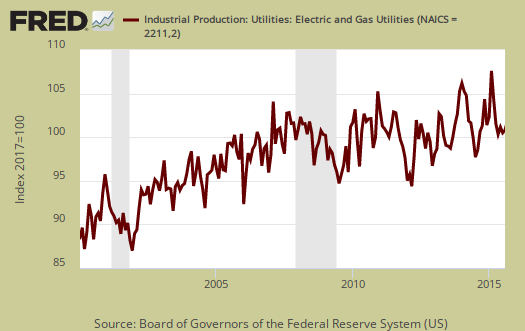
There are two reporting methodologies in the industrial production statistical release, market groups and industry groups. Market groups is output bundled together by market categories, such as business equipment or consumer goods and shown below:
The drop in the output of motor vehicles and parts contributed significantly to decreases of between 0.3 and 0.6 percent in August in each of the indexes for consumer goods, business equipment, and materials. Aside from motor vehicles and parts, the output of consumer goods increased 0.4 percent, with gains in many of its components. Likewise, the output of business equipment other than motor vehicles and parts moved up 0.4 percent, as an increase of about 1 percent in the output of industrial and other equipment more than offset decreases for information processing equipment and for the portion of transit equipment not related to vehicles. The decrease in the index for materials reflected both the drop in motor vehicle parts as well as declines for most other materials, with every category except paper recording losses. Among other major market groups, the output of defense and space equipment fell 1.2 percent, the output of business supplies rose 0.3 percent, and the output of construction supplies edged up 0.1 percent.
Capacity utilization, or of raw capacity, how much is being used, for total industry is 77.6%, an decrease of -0.4 percentage points from last month. . Capacity utilization has decreased by -0.6 percentage points from a year ago and is 2.5 percentage points below the long run average. This is a pretty horrific trend and shows a lot of slack in the economy. Manufacturing capacity utilization decreased by -0.4 percentage points for the month, is 75.8% and is 2.7 percentage points below it's long run average. Within manufacturing, durable goods capacity utilization is 75.8% and is 1.1 percentage points below the long term average Mining capacity utilization is 84.0%. Utilities use of it's capacity is 79.2%.
Capacity utilization is how much can we make vs. how much are we currently using, of what capacity is available now, or output rate. Capacity utilization is also called the operating rate. Capacity utilization is industrial production divided by raw capacity.
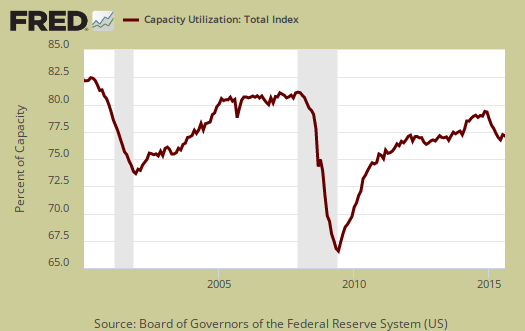
Capacity growth is raw capacity and not to be confused what what is being utilized. Instead, this is the actual growth or potential to produce. Capacity is the overall level of plants, production facilities, and ability to make stuff, that we currently have in the United States. Capacity growth overall has increased 1.6 percentage points from a year ago. Below is the capacity growth increase from a year ago of the subcategories which make up industrial production.
- Manufacturing: +1.1%
- Mining: +5.5%
- Utilities: +0.9%
Below is the Manufacturing capacity utilization graph, normalized to 2007 raw capacity levels, going back to the 1990's. One can see offshore outsourcing as the slope decreases. Pay particular attention to the 2001-2003 as manufacturing had a mass exodus to China after passage of the bad trade deal in 2000.
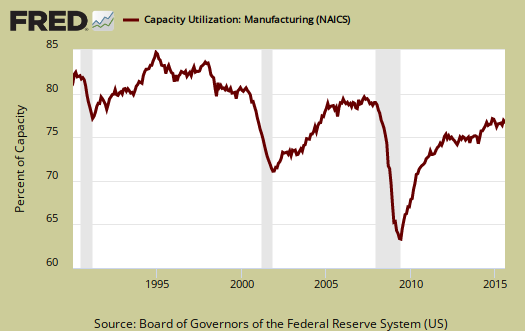
This report is really not so great, yet is it enough to cause the Fed to delay interest rates? That might more depend on deflation than this report. Yet if one looks at the first graph showing overall industrial production, that sure doesn't look robust now does it?
Here are our previous overviews, only graphs revised. The Federal Reserve releases detailed tables for more data, metrics not mentioned in this overview.

Recent comments